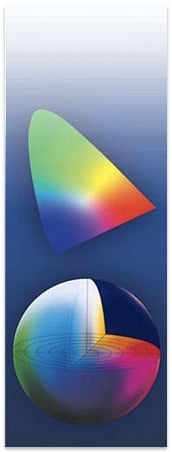
Optical Analysis
OVERVIEW
This lab is dedicated to all aspects of the optical performance of functional materials and coatings: This covers color and appearance aspects, optical properties, thin layer optics, light transport and last, but not least, stability under various environmental conditions.
Color and Appearance
Characterization of color and appearance of reflective, translucent and transmissive materials based on spectral UV/VIS/NIR photometry and visual flux measurement: Surface characteristics, such as gloss, haze, orange peel or distinctness-of-reflected-image is measured according to international standards (ASTM, ISO, …) or in view of other, specific machine or observer illumination / detection geometry. CIE color tolerancing. Colorimetric imaging goniometry is applied for assessment of the angular resonse of both, reflective or tranmissive materials (BRDF/BTDF) and emissive displays. Calibrated UV/VIS radiometry is available for characterization of light sources and displays. Furthermore, we provide spectrally resolved exposure of films (spectral sensitivity).
Image Capture and Image Analysis
We use a wide range of image acquisition techniques including high-end microscopes, scanners and high-dynamic range camera systems for image-wise capture of both, small details or large areas of materials on micron to decimeter scales. Control of illumination and detection geometries is the key for image capture at best possible contrast. Characterization of texture or small features with segmentation techniques (image analysis) is applied to quantify number frequency and quality of point and line attributes (point defects, scratches, rolling lines, letter quality, printed circuit, bar code quality, etc.) or homogeneity (noise, mottle, texture). Performance is analysed in view of of human visual perception (contrast sensitivity), specific characteristics of a machine vision interface (Fourier analysis) or other functional requirements.
Material Optics
Quantitative understanding of the optical performance of functional materials (coatings, films and displays) requires knowledge of their optical properties (n, k), which can be measured in the range 250 – 2500 nm via UV/VIS/NIR spectrophotometry (modeling in analogy to ellipsometry). Model-based ligh transport analysis in layer stacks of composite functional materials cover thin layer interference, light scattering due to inclusions (MIE scattering) and interface roughness (micro facets) in view of their effect on spectro-goniometric response. Typical applications cover optical layer thickness analysis of clear coatings, opacity, lateral light spread, depth absorption profiles of UV/VIS/IR radiation in scattering and absorbing media and analysis of complex optical security features.
TECHNIQUES
- Spectral reflection, transmission and haze, as well as optical properties (n, k) of materials and coatings in the range 250 – 2500 nm.
- Spectro-goniometric response of surfaces and coatings and their correlation to visual and technical performance: color / appearance and BRDF
- Colorimetric analysis and tolerance measurement (CIE L*a*b* and other systems)
- Radiometric characterization of light sources (lamps, UV curing) and displays in the range 250 – 850 nm.
- Bi-spectral UV/VIS photometry (for analysis of optical brighteners)
- “Physical” image capture of coatings and surfaces for assessment of fine structures and homogeneity: Choice of illumination / detection geometry and corresponding segmentation by image analysis.
- Information capacity of technical imaging materials and lithographic films (line quality, MTF)
- Modeling of (multiple) optical layer stacks: coatings with and without scattering inclusions.
- Model based optimization of functional coatings (antireflection coatings, particle size distribution, coatings for solar irradiation)
- Thickness determination of smooth, translucent coatings from 50 nm on
- Stability testing (service life and shelf-life): light, climate (T/%rH) and ozone
EQUIPMENT AND METHODS
- Various instruments for UV/VIS/NIR photometry with different geometry: 8/d, d/8, 45/0, 0/0; directional R/T: 15-75°, Center-Mount
- Colorimetric Imaging Goniometer for hemispherical goniometric response (up 88°)
- Hand-held and benchtop devices for color, gloss and haze
- Calibrated UV/VIS radiometry (light sources) and spectral exposure (film)
- Cameras with zoom versatile lenses and illumination, large area scanner, scientific microscope for “physical” high dynamic image acquisition
- Image Analysis via threshold and Segmentation techniques (Halcon, ImagePro+)
- Several Xe-arc weatherometers and fluorescent light fading units
- Various T/%rH controlled test chambers (180 – 800 liter)
- Ozone test chamber (180 liter, T/%rH controlled)
Let's Talk
Fill out this form, and we'll revert to you as soon as possible.
Please provide a detailed description of your question or request.
